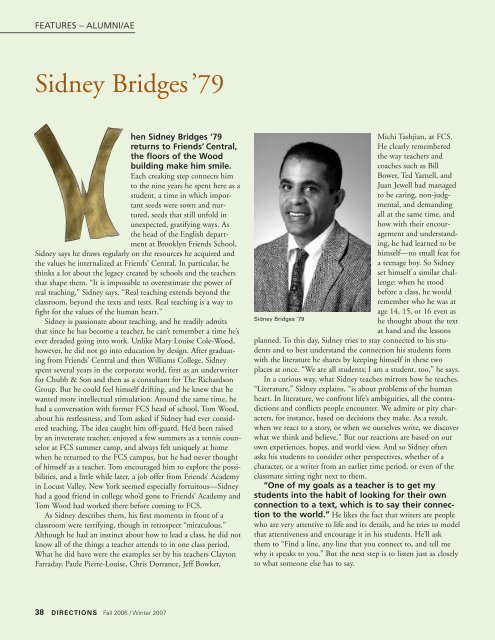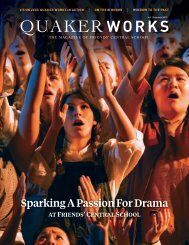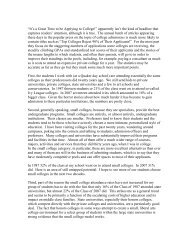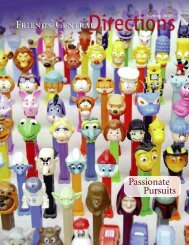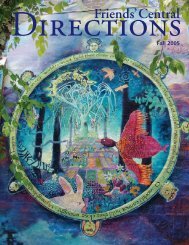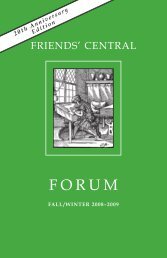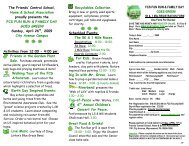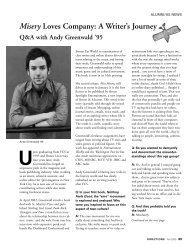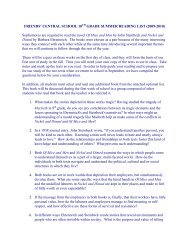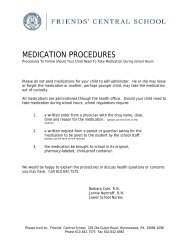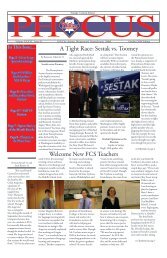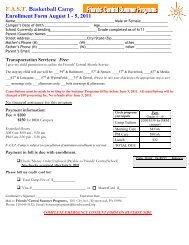2006-2007 Fall/Winter Directions - Friends' Central School
2006-2007 Fall/Winter Directions - Friends' Central School
2006-2007 Fall/Winter Directions - Friends' Central School
Create successful ePaper yourself
Turn your PDF publications into a flip-book with our unique Google optimized e-Paper software.
FEATURES – ALUMNI/AE<br />
Sidney Bridges’79<br />
hen Sidney Bridges ’79<br />
returns to Friends’ <strong>Central</strong>,<br />
the floors of the Wood<br />
building make him smile.<br />
Each creaking step connects him<br />
to the nine years he spent here as a<br />
student, a time in which important<br />
seeds were sown and nurtured,<br />
seeds that still unfold in<br />
unexpected, gratifying ways. As<br />
the head of the English department<br />
at Brooklyn Friends <strong>School</strong>,<br />
Sidney says he draws regularly on the resources he acquired and<br />
the values he internalized at Friends’ <strong>Central</strong>. In particular, he<br />
thinks a lot about the legacy created by schools and the teachers<br />
that shape them. “It is impossible to overestimate the power of<br />
real teaching,” Sidney says. “Real teaching extends beyond the<br />
classroom, beyond the texts and tests. Real teaching is a way to<br />
fight for the values of the human heart.”<br />
Sidney is passionate about teaching, and he readily admits<br />
that since he has become a teacher, he can’t remember a time he’s<br />
ever dreaded going into work. Unlike Mary Louise Cole-Wood,<br />
however, he did not go into education by design. After graduating<br />
from Friends’ <strong>Central</strong> and then Williams College, Sidney<br />
spent several years in the corporate world, first as an underwriter<br />
for Chubb & Son and then as a consultant for The Richardson<br />
Group. But he could feel himself drifting, and he knew that he<br />
wanted more intellectual stimulation. Around the same time, he<br />
had a conversation with former FCS head of school, Tom Wood,<br />
about his restlessness, and Tom asked if Sidney had ever considered<br />
teaching. The idea caught him off-guard. He’d been raised<br />
by an inveterate teacher, enjoyed a few summers as a tennis counselor<br />
at FCS summer camp, and always felt uniquely at home<br />
when he returned to the FCS campus, but he had never thought<br />
of himself as a teacher. Tom encouraged him to explore the possibilities,<br />
and a little while later, a job offer from Friends’ Academy<br />
in Locust Valley, New York seemed especially fortuitous—Sidney<br />
had a good friend in college who’d gone to Friends’ Academy and<br />
Tom Wood had worked there before coming to FCS.<br />
As Sidney describes them, his first moments in front of a<br />
classroom were terrifying, though in retrospect “miraculous.”<br />
Although he had an instinct about how to lead a class, he did not<br />
know all of the things a teacher attends to in one class period.<br />
What he did have were the examples set by his teachers Clayton<br />
Farraday, Paule Pierre-Louise, Chris Dorrance, Jeff Bowker,<br />
38 DIRECTIONS <strong>Fall</strong> <strong>2006</strong> / <strong>Winter</strong> <strong>2007</strong><br />
Michi Tashjian, at FCS.<br />
He clearly remembered<br />
the way teachers and<br />
coaches such as Bill<br />
Bower, Ted Yarnell, and<br />
Juan Jewell had managed<br />
to be caring, non-judgmental,<br />
and demanding<br />
all at the same time, and<br />
how with their encouragement<br />
and understanding,<br />
he had learned to be<br />
himself—no small feat for<br />
a teenage boy. So Sidney<br />
set himself a similar challenge:<br />
when he stood<br />
before a class, he would<br />
remember who he was at<br />
age 14, 15, or 16 even as<br />
Sidney Bridges ’79<br />
he thought about the text<br />
at hand and the lessons<br />
planned. To this day, Sidney tries to stay connected to his students<br />
and to best understand the connection his students form<br />
with the literature he shares by keeping himself in these two<br />
places at once. “We are all students; I am a student, too,” he says.<br />
In a curious way, what Sidney teaches mirrors how he teaches.<br />
“Literature,” Sidney explains, “is about problems of the human<br />
heart. In literature, we confront life’s ambiguities, all the contradictions<br />
and conflicts people encounter. We admire or pity characters,<br />
for instance, based on decisions they make. As a result,<br />
when we react to a story, or when we ourselves write, we discover<br />
what we think and believe.” But our reactions are based on our<br />
own experiences, hopes, and world view. And so Sidney often<br />
asks his students to consider other perspectives, whether of a<br />
character, or a writer from an earlier time period, or even of the<br />
classmate sitting right next to them.<br />
“One of my goals as a teacher is to get my<br />
students into the habit of looking for their own<br />
connection to a text, which is to say their connection<br />
to the world.” He likes the fact that writers are people<br />
who are very attentive to life and its details, and he tries to model<br />
that attentiveness and encourage it in his students. He’ll ask<br />
them to “Find a line, any line that you connect to, and tell me<br />
why it speaks to you.” But the next step is to listen just as closely<br />
to what someone else has to say.


